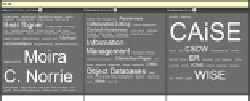Information Technology Reference
In-Depth Information
Framework
1
2
Language
Processor
Browser
Generator
3
6
5
SQL View
Manager
Tag Cloud
Generator
SQL
4
Database
Fig. 6.
Framework architecture and workflow
synchronised according to the selection. For this purpose, the view manager first
restricts the current view by temporarily extending the
WHERE
clause in order
to reflect the user selection. This updated view is then used as the starting point
for the
PROPAGATE-UPDATE
function shown in Fig. 7, which implements an
algorithm propagating the tag selection to associated views in order to keep
them synchronised.
PROPAGATE-UPDATE
(
View
)
1
N ←∅
2
N ←
GET-ASSOCIATED-VIEWS
(
View
)
3
for
∀
n
∈ N
4
do
ALTER-VIEW
(
View,
n)
PROPAGATE-UPDATE
(n)
5
Fig. 7.
Update Propagation Algorithm
For the view passed as the argument, the set
N
of all associated views are
retrieved using the
GET-ASSOCIATED-VIEWS
function. For every view
n ∈ N
,
the view creation statement is extended by a join operation with respect to the
view argument. Such extensions are carried out by the
ALTER-VIEW
function.
Then, the
PROPAGATE-UPDATE
function is invoked recursively, in order to
propagate the selection to all views related to the one currently processed. Note
that, if multiple tags are selected subsequently, the algorithm is executed for
each affected entity.
As a result, the selection of a tag is propagated along the relationships among
database relations and, therefore, all related tag clouds are synchronised. For
example, if a conference tag is selected, the view associated with the tag cloud is
extended in order to filter the selected conference. Next, all associated views are
determined, which, in our publication browser example, would be the publica-
tions and authors views. Then, the publications view would be filtered for those
publications that were published in the selected conference. Finally, the authors


























